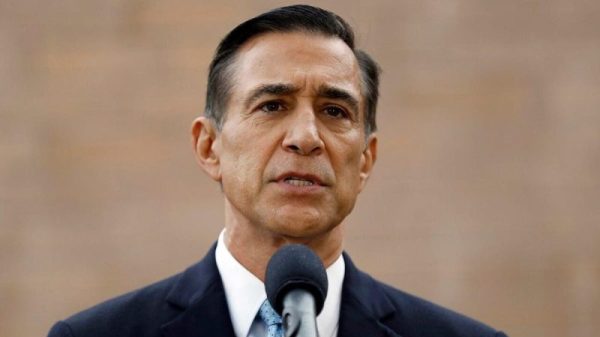“We had the best unemployment rates ever. And they were real unemployment, not like you have today where nobody’s working and they consider it to be. It’s a whole different thing. Too complicated to explain, but it’s a whole different thing. You don’t have to know about it.”
— Former president Donald Trump, remarks in Rochester, N.H., Jan. 21
The U.S. economy is doing pretty well, with ample job growth and low unemployment. After the shock of post-pandemic-shutdown inflation, however, Americans until recently seemed pretty grumpy about the economy and had little inclination to give the Biden administration much credit, even as inflation has been easing (and the United States had done much better than its peer countries).
But surveys increasingly show that Americans have begun to appreciate the state of the economy. On Friday, the University of Michigan reported that consumer sentiment had reached its highest level in 2½ years, with Americans believing the worst of inflation had passed. The rise in optimism was consistent across all age and income groups, education and geographical locations — and even political affiliation. That all bodes well for the president’s reelection campaign.
So naturally Trump is reaching back to the playbook he used in the 2016 election, when the economy was also on an upswing — suggesting the unemployment numbers are fake. And naturally he falsely claims that he had the best unemployment rate ever — when in fact Biden beat him (and neither has bested the unemployment rates reached in the Truman and Eisenhower administrations).
During the 2016 campaign, Trump often questioned the accuracy of the employment numbers published by the Bureau of Labor Statistics. While the official unemployment rate was about 5 percent, Trump claimed it was really 22 percent or even as high as 42 percent.
“Don’t believe those phony numbers when you hear 4.9 and 5 percent unemployment,” Trump declared after he won the New Hampshire primary. “The number’s probably 28, 29, as high as 35. In fact, I even heard recently 42 percent.”
In a speech to the Economic Club of Detroit that August, Trump said the unemployment rate was “one of the biggest hoaxes in modern politics.” On many other occasions, he derided the figures calculated by federal career economists as “phony.” Even after he was elected and before he took office, Trump asserted at a December rally, “the unemployment number, as you know, is totally fiction.”
But all of that seemed to be forgotten once the jobs report of the first full month under Trump was released on March 10, 2017. Trump retweeted a Drudge Report headline that the economy gained 235,000 jobs, even though as a candidate he had dismissed that kind of jobs gain as insignificant. Trump was so quick to spread the news that he violated a federal rule that prohibits the executive branch from commenting on data released by federal agencies within an hour of its release.
Then-White House press secretary Sean Spicer was asked by reporters about the contradiction between Trump’s campaign stance and his eagerness to embrace BLS math as president. His response: “I talked to the president prior to this and he said to quote him very clearly. ‘They may have been phony in the past, but it’s very real now.’”
After that shameless response, for the rest of his presidency, Trump not only embraced the official unemployment rate — which continued a decline that began in the Obama administration — but he routinely claimed he had set record lows.
That was false. The unemployment rate during Trump’s presidency, as measured by the BLS, reached a low of 3.5 percent in September 2019 and February 2020. That was the lowest in 50 years, but the unemployment was lower than that in much of 1951, 1952 and 1953 — and even reached 2.5 percent in 1953. Moreover, the unemployment rate touched 3.4 percent, in a couple of months in 2023, under Biden. (Biden had a lot of catching up to do, as the unemployment rate was 6.4 percent when he took office.) So Trump cannot even claim the half-century record.
But now that Trump is running for president again, he is again sowing doubt about the unemployment numbers. In New Hampshire on Sunday, he said the numbers during his presidency “were real unemployment, not like you have today where nobody’s working and they consider it to be.” He didn’t go into detail — saying it was “too complicated to explain” — which appears to be code for “trust me.”
When we asked Trump campaign spokesman Steven Cheung for an explanation, he emailed a link to a year-old article by our colleagues at FactCheck.org. This was puzzling, to say the least. The article said that Biden, speaking at a conference, had botched a statistic, using data for people receiving unemployment benefits when he referred to people being out of work. A spokesman said that Biden used the wrong phrasing — and FactCheck.org concluded that Biden’s statistic was “nearly accurate” if he had specified he was talking about unemployment benefits.
There’s nothing in the article to support Trump’s claim — and Cheung did not respond to a follow-up email seeking clarification.
Biden’s mix-up of people collecting unemployment benefits and the number of unemployed is relatively common, according to the BLS. Not everyone applies for benefits — or benefits run out — so the BLS’s estimates of the unemployment rate are based on a monthly sample survey of 60,000 households conducted by the Census Bureau. People are classified as unemployed if they do not have a job, have actively looked for work in the prior four weeks, and are available for work. These answers become part of the official unemployment measure.
There are actually six versions of the unemployment rate, but the official unemployment rate is called U-3. That reflects an internationally embraced definition set by the International Labor Organization — that the “unemployed” are people who are not working but have actively searched for work, are available to work, and are willing and able to work for pay.
Trump has no basis to suggest that the unemployment numbers are being cooked. The career professionals at the BLS are collecting the data the same way they did before he was president, when he was president and after he was president.
But now that views on the economy have shifted toward a more positive note, Trump is cynically suggesting the numbers can’t be trusted. It was ever thus.
(About our rating scale)
Send us facts to check by filling out this form
Sign up for The Fact Checker weekly newsletter
The Fact Checker is a verified signatory to the International Fact-Checking Network code of principles







































